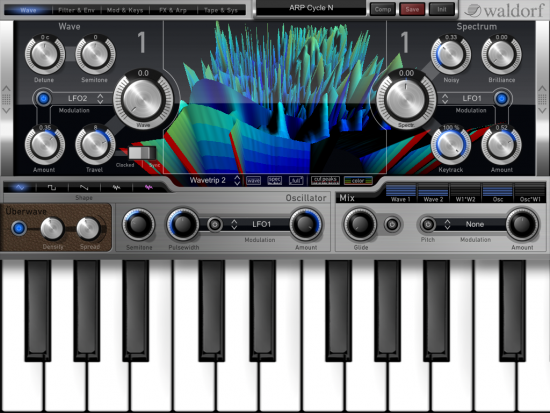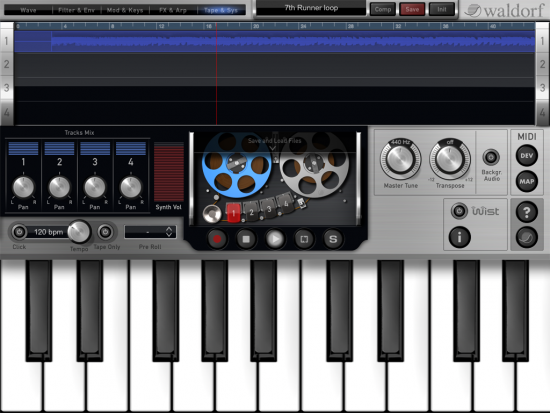Waldorf is a legendary name in synthesizers. Their Micro Q rackmount synth has been part of my sound arsenal for years. Recently, the company introduced Nave — their first foray into the world of iPad sound creation.
Nave is a very powerful wavetable synth app, capable of unique sounds unreachable by other iOS synthesizers — including speech synthesis. It also features a thoughtful interface that allows the user to control the waves in innovative ways. It is even possible to generate new wavetables from audio files.
Nave for the iPad Features
- Each Voice Features 2 Wave Oscillators and Separate Oscillator
- 6 Oscillator Types Including the Uberwave Osc
- 2 Ring Modulators, 3 Envelopes, 2 LFOs
- Multimode Filter with LP, HP, and BP options
- Effects Include Delay, Reverb, Compression, Flanger, Chorus, EQ, Phaser
- Unique Graphic Wavetable Interface
- Programmable Arpeggiator
- Full MIDI Implementation
- 4-Track “Tape” Recorder
- Audiobus Compatible
- Normally Priced at $19.99 at the App Store
Fans of Waldorf’s hardware synths need to check out Nave. It combines the sonic innovation of the company who brought the Micro Q and Blofield hardware synths into the world with the unique control aspects made possible by the iPad interface. It is truly one of the top synth apps on the iOS platform.
Catching a Wave with Nave
Each Nave patch includes two wave modules each with its own modulator and a separate oscillator (including the 8-oscillator “Uberwave”) that gets mixed into the overall sound. It is possible to modulate the wave modules with each other or the first module with the oscillator to create Ring Modulation effects. A multimode filter adds to the subtractive synthesis love, and a full array of envelopes, LFOs, and effects powered by some unique touchscreen tweaking options flesh out this synth app.

Nave features a solid interface centered around the Wave Menu page which provides a graphical representation of the currently loaded wavetable. A simple flick on the slip field control swaps between the two wave modules. The Wave Menu page also allows control of the oscillator settings for the patch, as well as the mixer and some of LFO and other modulation functionality.
The app comes with a ton of wavetables — and get this — you can load up your own audio files and/or type some words to build a speech synthesis wavetable. In short, Nave’s sonic possibilities are almost limitless. It is also possible to manipulate the wavetable graphically with a full range of support for iOS gestures, or by using some of the app’s tools like the Ribbon band.
Filters and Envelopes
The Filter and Envelope Page controls the settings for Nave’s multimode filter and the synth’s three main envelopes. Convenient editable graphic displays for the filter response and envelope waveforms leverage the iPad’s touchscreen for some interesting real-time sonic modifications. There are also virtual knobs for cutoff, resonance, and drive amount — the latter adds a nice saturation to the overall patch sound and can be routed either pre or post filter or EQ.
There is one envelope each for the filter and amplifier, while the third can be added to any other module using the modulation matrix. As mentioned earlier, the envelopes can be edited using the graphical display as well as by using the same slider interface as the mixer.
Effects, and a Modulation Matrix
The Modulation and Keyboard Page provides access to Nave’s LFO settings, the modulation matrix, and the parameters for the virtual keyboard. The available shapes for the two LFOs include sine, triangle, square, sawtooth (down and up), as well as Sample and Hold. It is possible to sync the two together as well as letting them be controlled by the tempo for the synth patch.
With 10 slots, the modulation matrix offers many options for sonic mindfreak on each patch. The interface is easy enough to use, providing dropdowns for source and destination, and slider control for amount. Three X-Y pads — one always visible on this page and two able to replace the keyboard if desired — add even more options for touchscreen mayhem.
The virtual keyboard also features a Blade option, similar to the Animoog keyboard interface, with the ability to add modulations by swiping horizontally or vertically on the touchscreen. The keyboard can be displayed in three different sizes as well.
Nave provides an internal mod effects unit capable of flanging, phasing, and chorus, and there are individual units for Delay, Reverb, EQ and Compression. The knob-based interface for all the effects works well. A programmable arpeggiator that provides more functionality than a typical synth app versions rounds out the sonic capabilities.

A final page contains the system functions and a 4-track recorder which provides a measure of convenience, but isn’t really needed in these days of Audiobus. Frankly, a step sequencer would have been a better choice for the coding effort. A variety of audio copy functions exist on Nave, and in addition to Audiobus, the app supports other iOS music standards, like WIST, Inter App Audio, Background Audio, and Core MIDI.
Nave is a powerful synth app and an excellent example of what’s possible on the iOS platform. This app is must get for iPad-owning synth freaks. For their next app, Waldorf should release an iOS version of their excellent drum machine desktop plug-in, Attack!

Pingback: Waldorf Nave gets an Update -- and Other News | TabMuse -- a Home for Digital and Analog Music Inspiration
Pingback: Z3TA+ is a Cakewalk among iPad Synth Apps | TabMuse -- a Home for Digital and Analog Music Inspiration
Pingback: Stroke Machine Attacks the iPad Drum Machine Scene | TabMuse -- a Home for Digital and Analog Music Inspiration
Pingback: A Venerable Chord Organ is yours with iOptigan for the iPad | TabMuse -- a Home for Digital and Analog Music Inspiration